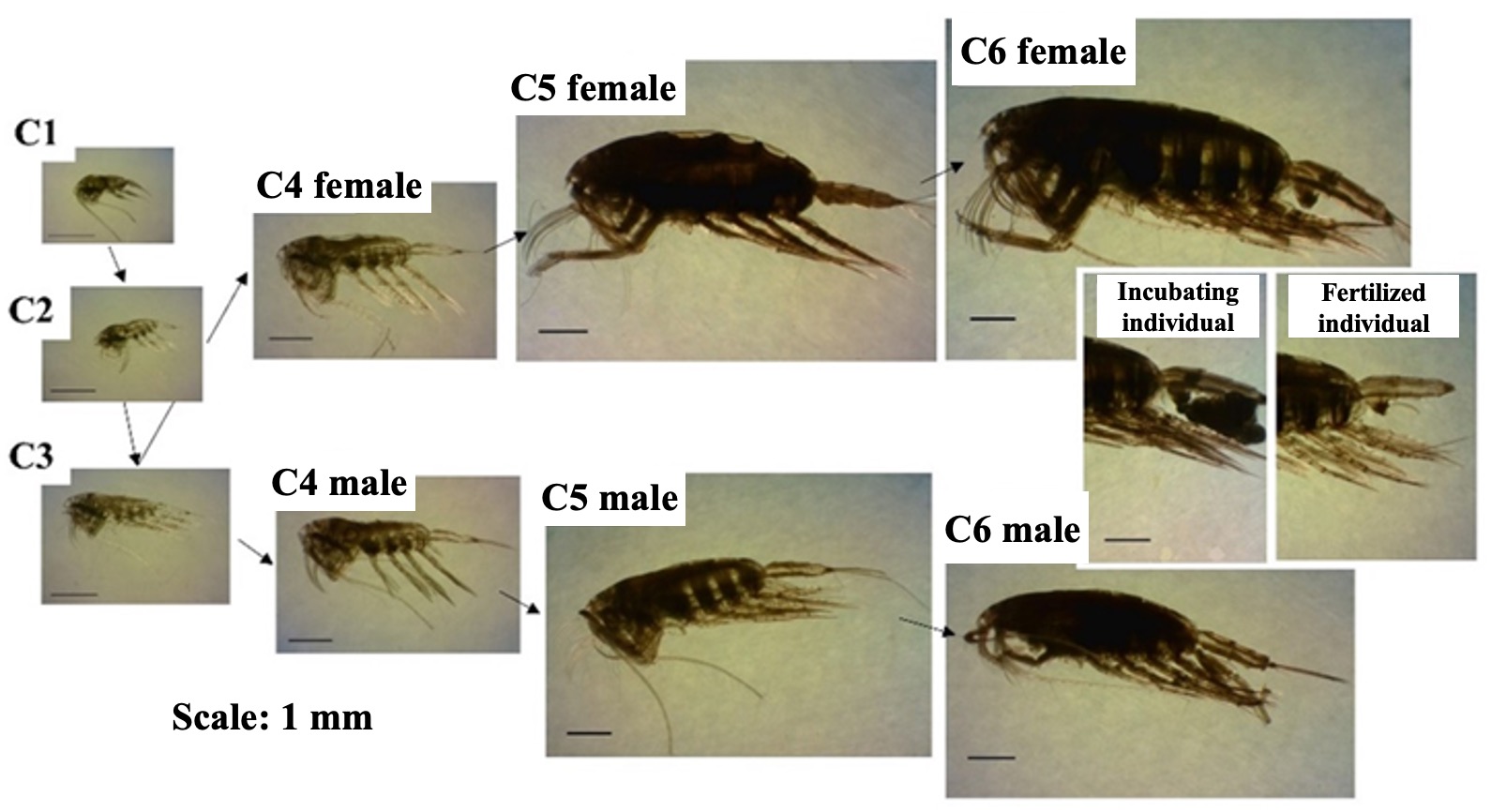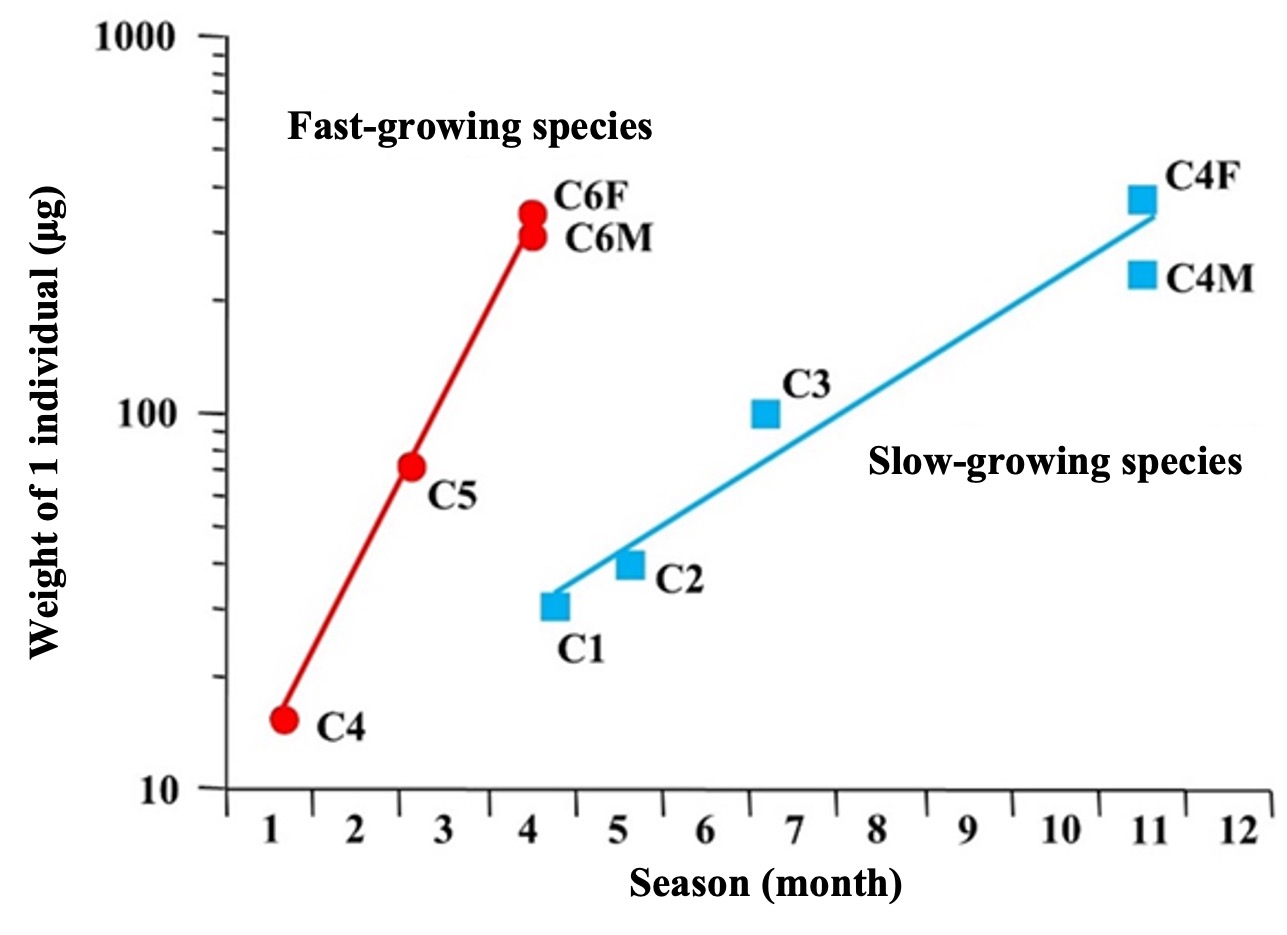Clarifying the Life History of Two Zooplankton Species in the Arctic Ocean
主題大綱
-
・Plankton samples collected over a one-year period from a fixed point on ice in the Arctic Ocean were analyzed.
・Clarifying the life histories of two carnivorous copepods that dominate the zooplankton fauna of the Arctic Ocean.
・Important findings as past environmental data for future expected changes in the Arctic marine ecosystem due to climate change.
-
Associate Professor YAMAGUCHI Atsushi of the Graduate School of Fisheries Sciences, Hokkaido University, and his research group from Woods Hole Oceanographic Institution and the University of Rhode Island in the United States analyzed zooplankton samples collected over a one-year period from 1997 to 1998 at fixed points on ice in the Arctic Ocean to clarify the life history of two carnivorous species of zooplankton that are dominant in the Arctic Ocean zooplankton fauna.
Since the Arctic Ocean is frozen over during the winter, it is difficult to collect plankton samples throughout the year, and samples collected throughout the year are extremely rare, and knowledge of zooplankton life histories has been scarce. The time series of plankton samples collected from 1997 to 1998 from an icebreaker in Canada as a stationary base on the ice are known as SHEBA samples. The research group analyzed the SHEBA samples to clarify the life histories of two carnivorous copepod species that are dominant in zooplankton. In the Arctic marine ecosystem, carnivorous copepods not only feed on fish, which are higher-order predators, but also play an important role in influencing the material cycle in the lower marine ecosystem by preying on early-stage individuals of larger, particle-eating copepods.
The results of this research will provide important information on past marine lower-order ecosystems for assessing future changes in the Arctic Ocean marine ecosystem expected to occur due to climate change. The results of this research were published in the Journal of Plankton Research on Saturday, April 23, 2022.

Ice fixed station established in the Arctic Ocean from October 1997 to October 1998. The Canadian icebreaker that served as the base for observations and sampling (photo by Dr. Donald K. Perovich)
-
The Arctic Ocean has been experiencing rapid warming in recent years. The effects of global warming on marine ecosystems are first seen in the plankton that make up the lower-order marine ecosystems, which have short generation times. However, the seasonal freezing of the Arctic Ocean makes it difficult to collect plankton samples throughout the year, and little is known about their life histories. In order to collect plankton samples throughout the year, it is effective to establish a fixed station on the ice and conduct time-series sampling. The most successful time-series plankton collection ever conducted using a fixed station on ice was the research project "SHEBA," which used an icebreaker in Canada as an observation base from October 1997 to October 1998 (see figure below). The zooplankton samples collected during this project are referred to as SHEBA plankton samples. The life history of "particle-feeding copepods (zooplankton that feed on phytoplankton)" was reported by researchers at the Woods Hole Oceanographic Institution, but the life histories of other species remained unclear.
-
From October 1997 to October 1998, the SHEBA research project was conducted using a Canadian icebreaker moored on an ice block in the western Arctic Ocean as the observation and collection base (see figure below). During the SHEBA, zooplankton stratified collections were conducted approximately once every two weeks, and the samples were fixed in 4% formalin seawater (Fig. 1).
Associate Professor Yamaguchi of TUMSAT collaborated with researchers at the Woods Hole Oceanographic Institution in the U.S. to identify and count the two dominant carnivorous copepods in the zooplankton samples by developmental stage and reproductive state (Fig. 2).

Fig. 1. Zooplankton samples collected at fixed stations on ice over a period of one year.

Fig. 2. Carnivorous copepods of zooplankton emerging in a plankton sample. Copepods are crustaceans that molt and grow into parents. Reproductive timing is determined by the presence or absence of fertilization and egg incubation.
-
Two carnivorous copepods were dominant in the samples: one was the large-sized Paraeuchaeta glacialis and the other was the small-sized Heterorhabdus norvegicus. Both species are carnivorous, but their feeding and reproductive patterns are known to be very different. Paraeuchaeta glacialis is an ambush feeder, holding relatively large eggs until they hatch. Heterorhabdus norvegicus, on the other hand, has a poisonous needle for feeding that allows it to feed on zooplankton that are large relative to its body size, but its eggs are very small and it lays many small eggs in the water without incubating them. The reproduction of both species was found to occur during the polar night in the Arctic Ocean, when there is no sunlight. The growth rate of Heterorhabdus norvegicus, which uses a poisonous needle for feeding and lays a lot of small eggs, is rapid, whereas that of Paraeuchaeta glacialis, which uses an ambush feeding pattern and holds relatively large eggs until they hatch, is slow (Figure 3).
The life histories of two carnivorous copepods, which are important as a zooplankton link between vegetivorous zooplankton and fish, were clarified using SHEBA samples.

Fig. 3. Two carnivorous copepod species exist: a fast-growing species (red: Heterorhabdus norvegicus) and a slow-growing species (blue: Paraeuchaeta glacialis).
-
This study revealed that although the two carnivorous copepod species that dominate the zooplankton fauna have the same timing of reproduction, the subsequent growth rate and mode of reproduction differ significantly among the species. Both species reproduced during the polar night, which is conventionally considered a time of low biological production due to the lack of sunlight. The results of this study indicate that the polar night in the Arctic Ocean is more biologically active than previously thought. Although the reproductive timing of both species is the same, the subsequent growth rates of the two species differ significantly. In the Arctic marine ecosystem, carnivorous copepods not only feed on fish, which are higher-order predators, but also prey on early-stage individuals of larger particle-eating copepods, playing an important role in the material cycle in the marine lower-order ecosystem. Therefore, which of these carnivorous copepods adapts and increases its population in response to future changes in the marine environment will determine how the material cycle within the lower marine ecosystem will change. The present study is positioned to clarify the ecology of zooplankton in the past environment, which is important as a control material for the current changing environment.
Through the results of this research, we can expect to be able to assess future changes in the marine ecosystem in the Arctic Ocean.
-
・Paper title
Comparison of population structure, vertical distribution, and growth of sympatric, carnivorous, mesopelagic copepods, Paraeuchaeta glacialis and Heterorhabdus norvegicus, in the western Arctic Ocean
・Author
YAMAGUCHI Atsushi1,2,Carin Ashjian3,Robert Campbell4(1Graduate school of fisheries sciences, Hokkaido university, 2Arctic Research Center, Hokkaido University, 3Woods Hole Oceanographic Institution, U.S.A., 4University of Rhode Island, USA)
・Journal
Journal of Plankton Research(Journal of Planktonology)
・DOI
10.1093/plankt/fbac019/6572651
・Date of Publication
Saturday, April 23, 2022 (online publication)
